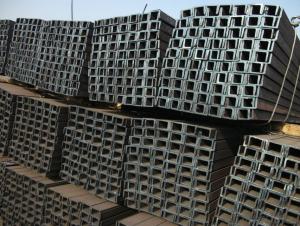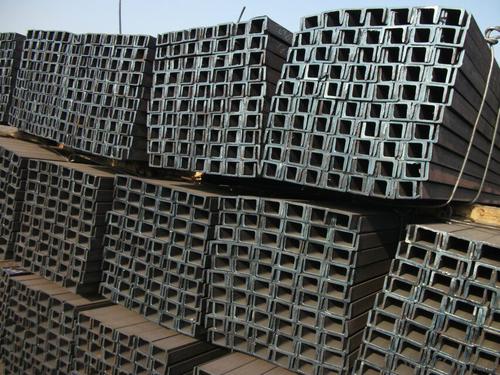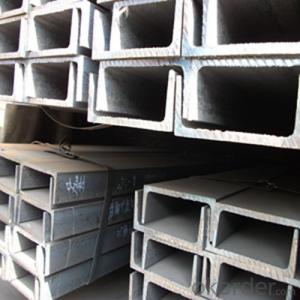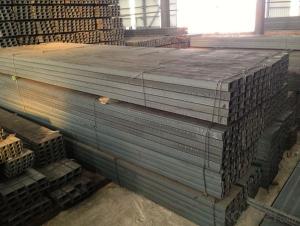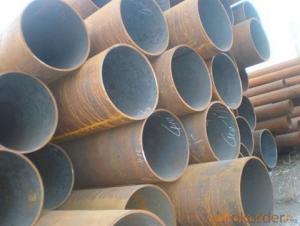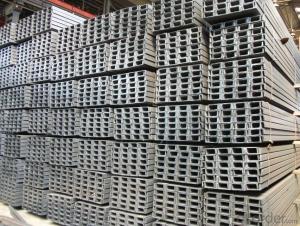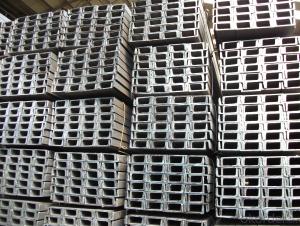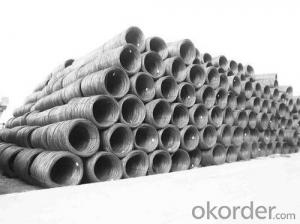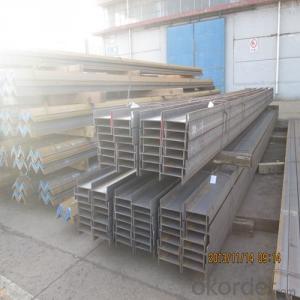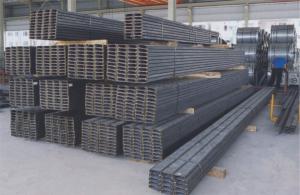Supply JIS Standard U Channel Steel in Sale
- Loading Port:
- Tianjin
- Payment Terms:
- TT OR LC
- Min Order Qty:
- 25 m.t.
- Supply Capability:
- 5000 m.t./month
OKorder Service Pledge
OKorder Financial Service
You Might Also Like
Specification
high quality Hot Rolled Steel U Beam at great prices with worldwide shipping. Our supplier is a world-class manufacturer of steel, with our products utilized the world over. OKorder annually supplies products to European, North American and Asian markets. We provide quotations within 24 hours of receiving an inquiry and guarantee competitive prices.
We supply high quality MS Channel at reasonable price, including Chinese standard, Japanese standard and so on.
Standard | GB/JIS |
Material Grade | Q235,SS400 |
Technique: | Hot Rolled |
Sizes as per chinese standard: | 50*37*4.5mm - 300*89*11.5mm |
Sizes as per japanese standard: | 50*25*3mm – 200*80*7.5mm |
Length: | 6meter, 9meter, 12meter |
Product Applications:
Hot Rolled Steel U-Beams are ideal for structural applications and are widely used in the construction of buildings and bridges, and the manufacturing, petrochemical, and transportation industries.
Product Advantages:
OKorder's Steel U-Beams are durable, strong, and resist corrosion.
Main Product Features:
· Premium quality
· Prompt delivery & seaworthy packing (30 days after receiving deposit)
· Corrosion resistance
· Can be recycled and reused
· Mill test certification
· Professional Service
· Competitive pricing
Product Specifications:
Manufacture: Hot rolled
Grade: Q195 – 235
Certificates: ISO, SGS, BV, CIQ
Length: 6m – 12m, as per customer request
Packaging: Export packing, nude packing, bundled
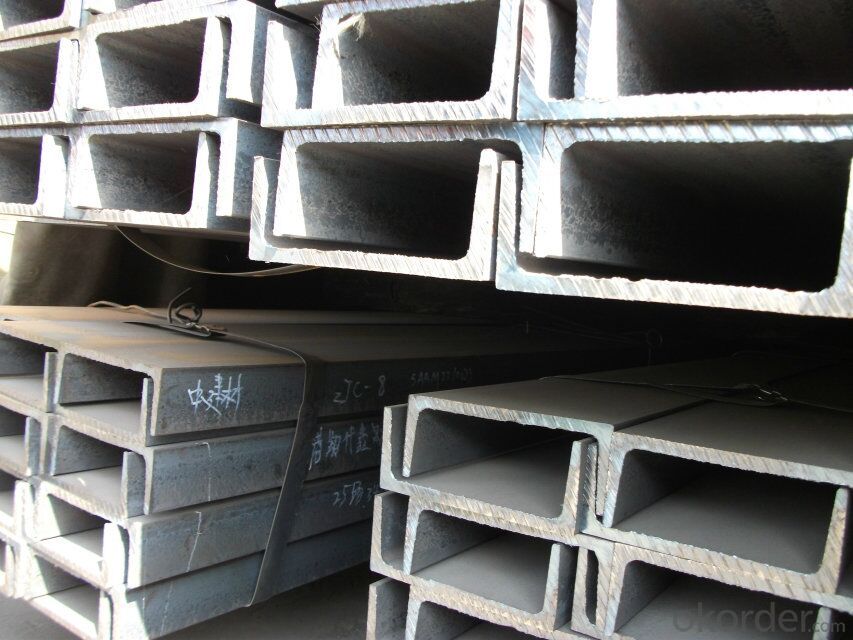

- Q: When building a high building, in order to take scaffolding, the channel into the wall, support scaffolding, etc., after the completion of scaffolding dismantled, channel after taking out, although the hole will be filled well, but the building will not leak it? The building I bought a total of 32 layers, wherein the 9 layer, 17 layer, 25 layer into the channel, I bought 17 layers, the future will Water Leakage ah, good fear, a knowledgeable friend to help answer,...
- Holes filled well will not leakBut often it doesn't fill well
- Q: What are the fire rating requirements for steel channel structures?
- The fire rating requirements for steel channel structures are dependent on a variety of factors, which include the building code, occupancy type, and the purpose of the structure. The overall aim is to ensure the safety of occupants and prevent fire from spreading. Fire ratings for steel channel structures are determined by building codes, which take into account the occupancy classification and the height of the structure. For instance, in the United States, the International Building Code (IBC) outlines specific fire resistance requirements for residential, commercial, and industrial buildings. The fire rating of a steel channel structure signifies the amount of time it can endure the effects of fire without compromising its structural integrity. This rating is typically expressed in minutes or hours. A higher fire rating indicates that the structure can withstand fire for a longer duration, allowing more time for evacuation and firefighting. There are various methods used to achieve the required fire rating. One common approach involves applying fire-resistant materials like fire-rated gypsum board or intumescent coatings to the steel channels. These materials provide insulation and shield the steel from the intense heat during a fire. Additionally, structural engineers may incorporate specific fire-resistant features into the design of steel channel structures, such as fireproofing coatings, fire barriers, or fire-resistant insulation. These measures help prevent the rapid spread of fire and minimize heat-related damage. To determine the specific fire rating requirements for steel channel structures in a particular jurisdiction, it is crucial to consult the local building code and engage the services of a qualified structural engineer. Adhering to these requirements ensures that the structure meets necessary safety standards and can effectively withstand fire incidents.
- Q: What are the tolerance limits for steel channels?
- The tolerance limits for steel channels depend on various factors such as the manufacturing process, the specific type of steel channel, and the industry standards. Generally, tolerance limits refer to the acceptable deviation from the specified dimensions or properties of the steel channels. In terms of dimensions, tolerance limits may include tolerances for width, height, and thickness of the channel. These limits ensure that the channels meet the required specifications and can be used effectively in various applications. For example, the tolerance limits for the width of a steel channel might be ±0.005 inches, meaning the actual width of the channel can vary within this range. Additionally, tolerance limits may also apply to other properties of steel channels such as straightness, squareness, and surface finish. Straightness tolerance ensures that the channel is not bent or warped beyond acceptable limits. Squareness tolerance ensures that the corners of the channel are at right angles to each other. Surface finish tolerance refers to the smoothness and quality of the channel's surface. It is important to note that different industries and applications may have specific tolerance requirements. For instance, channels used in structural engineering and construction may have different tolerance limits compared to channels used in manufacturing or fabrication processes. To determine the exact tolerance limits for steel channels, it is necessary to refer to industry standards and specifications such as those provided by organizations like the American Society for Testing and Materials (ASTM) or the International Organization for Standardization (ISO). These standards outline the acceptable tolerance limits for various dimensions and properties of steel channels, ensuring consistency and quality in their production and use.
- Q: Steel GB channel and non GB there is no difference?
- The so-called non standard steel (including steel), strictly speaking, is actually a kind of shoddy unqualified products, its thickness can not reach the minimum size standards, the actual use can not guarantee the components to meet the design requirements of the strength.
- Q: Can steel channels be used for staircases?
- Yes, steel channels can be used for staircases. Steel channels are often used as stringers, which are the structural supports for stairs. They provide strength, durability, and stability to the staircase, making them a popular choice in modern architectural designs.
- Q: Can steel channels be custom-made?
- Yes, steel channels can be custom-made. Steel channels are commonly used in construction and engineering projects, and their dimensions, length, and shape can be customized to meet specific requirements. Customization may involve altering the size, thickness, and material grade of the steel channels to suit the project's needs. This flexibility allows for a wide range of applications and ensures that steel channels can be tailored to fit various structural and design specifications.
- Q: Can steel channels be used for creating support structures for plumbing systems?
- Yes, steel channels can be used for creating support structures for plumbing systems. Steel channels provide strength and durability, making them suitable for supporting the weight of plumbing pipes and fixtures. They can be easily fabricated and installed, offering stability and longevity to plumbing systems.
- Q: How do steel channels contribute to the overall acoustics of a building?
- Steel channels can contribute to the overall acoustics of a building by reducing sound transmission and enhancing sound insulation. The use of steel channels helps in isolating noise between different areas within a building, preventing unwanted sound from traveling through walls and floors. Additionally, they can help in improving the overall sound quality within a space by reducing echoes and reverberation, creating a more pleasant and controlled acoustic environment.
- Q: How do steel channels perform under dynamic loads?
- Steel channels are known for their high strength and load-bearing capacity, making them well-suited for handling dynamic loads. When subjected to dynamic loads, such as vibrations, impacts, or fluctuating forces, steel channels exhibit excellent performance and durability. The structural design of steel channels allows them to effectively distribute dynamic loads throughout their length, preventing localized stress concentrations. This characteristic minimizes the risk of fatigue failure, which is crucial in applications where repeated loading occurs. Steel channels also possess good stiffness, which helps to maintain their shape and integrity under dynamic loads. This stiffness allows them to resist bending, twisting, or deforming, ensuring the overall stability and safety of the structure. Additionally, steel channels are highly ductile, meaning they can withstand significant deformation without fracturing. This ductility is essential in absorbing and dissipating energy during dynamic loading events, such as impacts or earthquakes, reducing the risk of catastrophic failure. Furthermore, steel channels are often used in conjunction with other structural components, such as bolts, welds, or connectors, to enhance their load-bearing capacity. The combination of steel channels with these reinforcements further improves their performance under dynamic loads by increasing their resistance to shear, torsion, and bending forces. In summary, steel channels are well-suited for handling dynamic loads due to their high strength, excellent load distribution capabilities, stiffness, ductility, and compatibility with reinforcements. These qualities make them a reliable choice for various applications that require withstanding dynamic forces, ensuring the durability and safety of the structures they are used in.
- Q: What is the minimum size of channel steel?
- The minimum size for the 5# channel channel, general specification for 50mm*50mm*3mm 50mm*50mm*4mm 50mm*50*mm5mm 50mm*50mm*6 mm, which is most commonly used, 50*50 is the right number, a digit number. Behind the thickness weight: General cross-sectional area 6.93cm2 theoretical weight 5.44kg/m, 5 channel theoretical weight is 5.438kg/m.
Send your message to us
Supply JIS Standard U Channel Steel in Sale
- Loading Port:
- Tianjin
- Payment Terms:
- TT OR LC
- Min Order Qty:
- 25 m.t.
- Supply Capability:
- 5000 m.t./month
OKorder Service Pledge
OKorder Financial Service
Similar products
Hot products
Hot Searches
Related keywords
